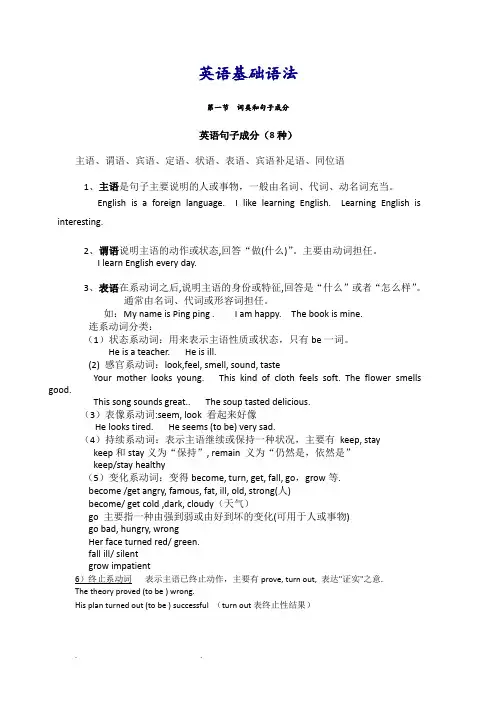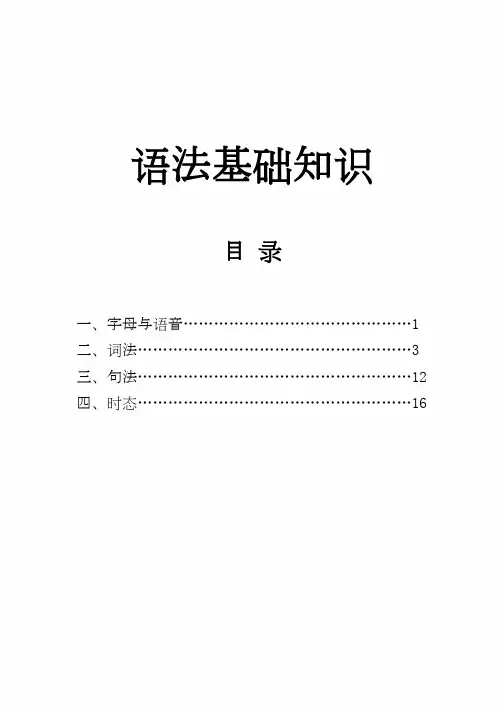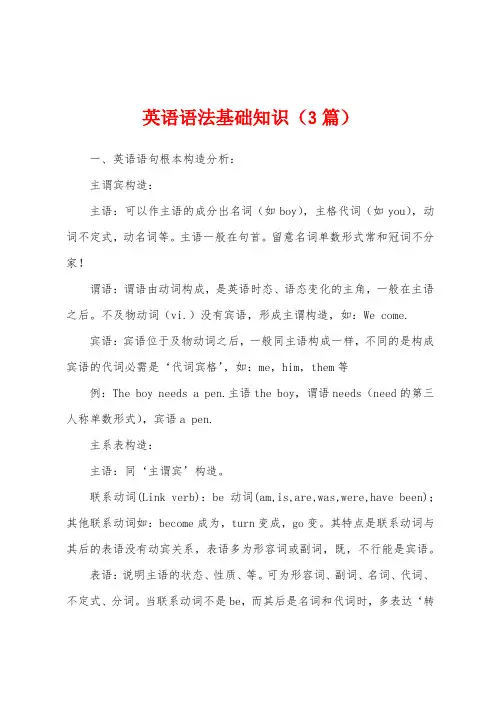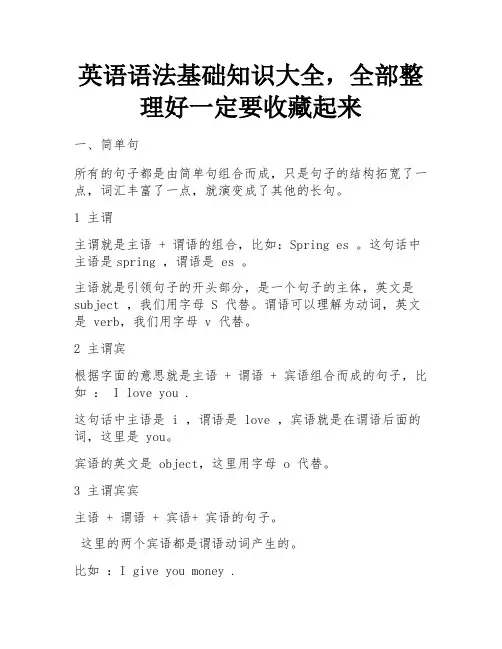英语语法基础知识
英语的语法基础知识

英语的语法基础知识英语语法基础知识包括一系列规则和结构,用于正确组织和理解英语句子。
以下是一些基本的英语语法概念:句子结构:主语和谓语:句子通常由主语(执行动作或被描述的实体)和谓语(动作或状态的核心)构成。
宾语:表示动作影响的对象。
词性(Parts of Speech):名词(Noun):表示人、事物、地点或概念。
动词(Verb):表示动作、状态或存在。
形容词(Adjective):描述名词或代词。
副词(Adverb):修饰动词、形容词或其他副词,表示方式、时间、地点等。
代词(Pronoun):替代名词的词语,如he、she、it等。
时态和语态:时态(Tense):表示动作发生的时间,包括过去、现在和将来时态。
语态(V oice):表示动作的执行者和承受者,包括主动语态和被动语态。
句子类型:陈述句(Declarative Sentence):陈述事实或观点。
疑问句(Interrogative Sentence):提问。
感叹句(Exclamatory Sentence):表示强烈情感。
从句和短语:定语从句(Relative Clause):描述名词的从句。
副词从句(Adverbial Clause):描述动词、形容词或副词的从句。
前置词和介词短语:前置词(Preposition):表示位置、方向、关系等的词语,如in、on、under 等。
介词短语(Prepositional Phrase):由前置词和其它词组成,描述名词或动词。
连词(Conjunction):并列连词(Coordinating Conjunction):用于连接同等重要的词组或句子,如and、but、or等。
从属连词(Subordinating Conjunction):引导从句,如because、although等。
这些是英语语法的一些基础概念,理解这些概念有助于构建准确、清晰的英语句子。
英语基础语法知识大全

英语基础语法第一节词类和句子成分英语句子成分(8种)主语、谓语、宾语、定语、状语、表语、宾语补足语、同位语1、主语是句子主要说明的人或事物,一般由名词、代词、动名词充当。
English is a foreign language. I like learning English. Learning English is interesting.2、谓语说明主语的动作或状态,回答“做(什么)”。
主要由动词担任。
I learn English every day.3、表语在系动词之后,说明主语的身份或特征,回答是“什么”或者“怎么样”。
通常由名词、代词或形容词担任。
如:My name is Ping ping . I am happy. The book is mine.连系动词分类:(1)状态系动词:用来表示主语性质或状态,只有be一词。
He is a teacher. He is ill.(2) 感官系动词:look,feel, smell, sound, tasteYour mother looks young. This kind of cloth feels soft. The flower smells good.This song sounds great.. The soup tasted delicious.(3)表像系动词:seem, look 看起来好像He looks tired. He seems (to be) very sad.(4)持续系动词:表示主语继续或保持一种状况,主要有keep, stay keep和stay义为“保持”, remain 义为“仍然是,依然是”keep/stay healthy(5)变化系动词:变得become, turn, get, fall, go,grow等.become /get angry, famous, fat, ill, old, strong(人)become/ get cold ,dark, cloudy(天气)go 主要指一种由强到弱或由好到坏的变化(可用于人或事物)go bad, hungry, wrongHer face turned red/ green.fall ill/ silentgrow impatient6)终止系动词表示主语已终止动作,主要有prove, turn out, 表达"证实"之意.The theory proved (to be ) wrong.His plan turned out (to be ) successful (turn out表终止性结果)4、宾语表示及物动词的对象或结果,回答做的是“什么”。
英语语法基础知识点

1. 基本句型:-主谓宾结构:这是最基本的句型,包括主语、谓语和宾语。
例如:“The cat chased the mouse.”(猫追老鼠。
)-主系表结构:包括主语、联系动词和表语。
联系动词通常是be动词(am, is, are, was, were等),表语通常是形容词或副词。
例如:“She is happy.”(她很快乐。
)2. 名词:名词是人、地点、事物或概念的名称。
单数名词常常和冠词(如the, a, an)一起使用。
3. 动词:动词表示行动或状态。
根据是否及物,动词分为及物动词和不及物动词。
不及物动词没有宾语,如“I laugh.”(我笑。
)-时态:表示动作的时间。
如:I am eating(现在进行时),I have eaten(现在完成时)等。
-语态:表示动作的执行者。
如:被动语态:“The book is read by him.”(书被他读了。
)4. 代词:代词是用来替换名词的词。
分为人称代词(我、你、他、她、我们、你们、他们)、物主代词(我的、你的、他的、她的、我们的、你们的、他们的)和指示代词(这、那、这些、那些)。
5. 形容词和副词:-形容词:用来修饰名词或代词,表示特征或状态。
如:beautiful(美丽的)、happy(快乐的)。
-副词:用来修饰动词、形容词或其他副词,表示程度、方式等。
如:quickly(快速地)、slowly(慢慢地)。
6. 介词:用来表示事物之间的关系,如位置、方向等。
如:in(在...里面)、on(在...上面)、under(在...下面)。
7. 连词:用来连接句子或词组,如:and(和)、but(但)、because(因为)。
8. 句子的种类:-简单句:只包含一个主语和一个谓语。
-复合句:包含两个或更多的主语和谓语,通过连词连接。
-复杂句:包含两个或更多的独立句子,通过标点符号或连词连接。
(完整版)英语语法入门基础知识

语法基础知识目录一、字母与语音 (1)二、词法 (3)三、句法 (12)四、时态 (16)语法基础知识一、字母与语音ɔ 主要字母组合的发音字母组合发音例词aralcar,bar,far,star small [a:][ɔ:]ayea play [ei][i :][ei]tea,beat,read,eat break,great bread [e]eeei[i :][ei]bee,see,Lee,jeep eight oo[u ]cook,foot,look,classroom boot,food,gooes,room coat,boat,goat oil [u :]oaoiu [ə ]ɔ[ i ]ir:[ə ]bird ooroyow[ :]door ɔɔ[ i ]boy [au ][ əu ][au ]how Know ouor house [ə:][ə]work,world,worse doctor,visitor,tractor morning [ɔ:]er[ə]sister,brother,mother,father her,term [ə:]irəbird,shirt,third,girl beer,deer,cheer turn [ :][ ə]eeruri [ə:][e ə]eirereeartheir [εə][i ə]there,where hear,fear [εə][εə][θ][ð]pear,bear,wear chair,hair airththree,thirty,thin,thousand this,those,these,they chick,click,cock,clockck [k ]0给大家推荐一个英语微信群Empty Your Cup英语微信群是目前学习英语最有效的方法,群里都是说英语,没有半个中文,而且规则非常严格,是一个超级不错的英语学习环境,群里有好多英语超好的超牛逼的人,还有鬼佬和外国美眉。
英语语法基础知识(3篇)

英语语法基础知识(3篇)一、英语语句根本构造分析:主谓宾构造:主语:可以作主语的成分出名词(如boy),主格代词(如you),动词不定式,动名词等。
主语一般在句首。
留意名词单数形式常和冠词不分家!谓语:谓语由动词构成,是英语时态、语态变化的主角,一般在主语之后。
不及物动词(vi.)没有宾语,形成主谓构造,如:We come.宾语:宾语位于及物动词之后,一般同主语构成一样,不同的是构成宾语的代词必需是‘代词宾格’,如:me,him,them等例:The boy needs a pen.主语the boy,谓语needs(need的第三人称单数形式),宾语a pen.主系表构造:主语:同‘主谓宾’构造。
联系动词(Link verb):be动词(am,is,are,was,were,have been);其他联系动词如:become成为,turn变成,go变。
其特点是联系动词与其后的表语没有动宾关系,表语多为形容词或副词,既,不行能是宾语。
表语:说明主语的状态、性质、等。
可为形容词、副词、名词、代词、不定式、分词。
当联系动词不是be,而其后是名词和代词时,多表达‘转变为’之意,留意与动宾关系的区分。
感官动词多可用作联系动词:look well/面色好,sound nice/听起来不错,feel good/感觉好,smell bad/难闻例:Tom is a boy.(Tom是个男孩)/主语为Tom,系词为be动词的第三人称单数is,表语为a boyThere be 构造:There be 表示‘存在有’。
这里的there没有实际意义,不行与副词‘there那里’混淆。
此构造后跟名词,表示‘(存在)有某事物’试比拟:There is a boy there.(那儿有一个男孩。
)/前一个there 无实意,后一个there为副词‘那里’。
二、定语:定语是对名词或代词起修饰、限定作用的词、短语或句子,汉语中常用‘……的’表示。
英语语法基础知识大全,全部整理好一定要收藏起来

英语语法基础知识大全,全部整理好一定要收藏起来一、简单句所有的句子都是由简单句组合而成,只是句子的结构拓宽了一点,词汇丰富了一点,就演变成了其他的长句。
1 主谓主谓就是主语 + 谓语的组合,比如:Spring es 。
这句话中主语是spring ,谓语是 es 。
主语就是引领句子的开头部分,是一个句子的主体,英文是subject ,我们用字母 S 代替。
谓语可以理解为动词,英文是 verb,我们用字母 v 代替。
2 主谓宾根据字面的意思就是主语 + 谓语 + 宾语组合而成的句子,比如: I love you .这句话中主语是 i ,谓语是 love ,宾语就是在谓语后面的词,这里是 you。
宾语的英文是 object,这里用字母 o 代替。
3 主谓宾宾主语 + 谓语 + 宾语+ 宾语的句子。
这里的两个宾语都是谓语动词产生的。
比如:I give you money .这里的 you 和 money 都是 give 的宾语,give you 和 give money ,所以都是两个宾语。
4 主谓宾宾补主语 + 谓语 + 宾语+ 宾补的句子。
比如:It makes me happy .这里的 me 是 make 的宾语,但是 happy 不是 make 的宾语。
happy 是 me 的形容词,是一个宾补,全称为宾语补足语,起到了补充说明的作用。
注意:区分主谓宾宾和主谓宾宾补主谓宾中的两个宾语都是谓语产生的动作词,而主谓宾补语是宾语的形容词,与谓语无关。
5 主系表这里,系统代表系动词。
包含三个类别A be 动词: am is are was wereB 感官动词(五官)look 看起来sound 听起来smell 闻起来taste 尝起来feel 摸着....感觉......C 变化动词bee / turn / go / get / grow这里的表是代表表语,包括名词、形容词、介宾短语、不定式todo比如 you are beautiful 这句话中,you 是主语,are 是系动词,beautiful 是表语。
英语语法基础知识大全
英语语法基础知识大全一. 词法1. 名词(1)名词的可数与不可数可数名词指表示的人或事物可以用数来计量,它有单数与复数两种形式。
不可数名词指所表示的事物不能用数来计量。
物质名词与抽象名词一般无法用数目,来统计,都成为不可数名词。
不可数名词前一般不能用冠词a、an来表示数量,没有复数形式。
要表示“一个……”这一概念,就须加a piece of这一类短语。
要注意许多名词在汉语里看来是可数名词,在英语里却不可数。
如:chalk,paper,bread,rice,grass,news等。
(2)名词复数的规则变化a.一般情况下加-s。
b.以s, x, ch, sh, 结尾的加-esc.以辅音字母加y结尾的改y为i再加-esd.以f,fe结尾的,去掉f或fe,变成v再加-es(3)名词的所有格a. 单数名词词尾加’s,复数名词词尾若没有s,也要加’s。
如:the worker‘s bike,the children’ s ballb. 表示几个人共有一样东西,只需在最后一个人的名字后加’ s若表示各自所有,则需在各个名字后’ s。
如:this is lucy and licy’ s room.these are kate‘s and jack’ s rooms.c. 如果是通过在词尾加—s构成的复数形式的名词,只加’。
如:the students’ books,the girls’ blouses(另外:名词+of+名词名词是有生命的,我们就用’s结构来表示所有关系。
如果名词所表示的事物是无生命的,我们就要用名词+of+名词的结构来表示所有关系。
)2. 代词人称代词,物主代词,反身代词,指示代词,不定代词(1)人称代词第一人称单数i me my mine myself复数 we us our ours ourselves第二人称单数you you your yours yourself复数you you your yours yourselves第三人称单数he him his his himselfshe her her hers herselfit it its its itself复数they them their theirs themselves(2)物主代词物主代词的用法:形容词性物主代词后面一定要跟上一个名词;名词性物主代词可作主语、表语、宾语。
英语语法基础知识大全
英语语法基础知识大全一、词类:英语中的词类包括名词(Noun)、动词(Verb)、形容词(Adjective)、副词(Adverb)、代词(Pronoun)、介词(Preposition)、连词(Conjunction)和感叹词(Interjection)。
名词:名词是用来表示人、事物、地点、观念等概念的词语,可以分为可数名词(Countable Noun)和不可数名词(Uncountable Noun)。
动词:动词是表示动作、状态、情感等的词语,可以分为及物动词(Transitive Verb)和不及物动词(Intransitive Verb)。
形容词:形容词是用来描述名词的性质、特征、状态等的词语,可以用来修饰名词或代替名词。
副词:副词是用来描述动词、形容词、其他副词等的词语,可以用来修饰句子、表达时间、地点、方式等。
代词:代词是用来代替名词的词语,可以分为人称代词、指示代词、不定代词、疑问代词、关系代词等。
介词:介词是用来表示位置、方向、时间、原因等的词语,通常与名词或代词连用,构成介词短语。
连词:连词是用来连接句子或词语的词语,可以分为并列连词、从属连词和关系连词。
感叹词:感叹词是用来表示强烈的情感、感叹、惊讶等的词语,通常放在句子开头或结尾。
二、句子结构:英语中的句子结构包括主语(Subject)、谓语(Predicate)、宾语(Object)、补语(Complement)、定语(Attributive)和状语(Adverbial)。
主谓一致:主语和谓语在人称和数上要保持一致。
三、时态:时态是表示动作发生的时间的形式,包括一般现在时、一般过去时、一般将来时等。
四、语态:语态是表示动作发生者和受动者关系的形式,包括主动语态和被动语态。
五、直接引语和间接引语:直接引语是直接引用别人的话,间接引语是对别人的话进行转述。
六、复合句:由一个主句和一个或多个从句组成的句子称为复合句。
从句可以分为名词性从句、形容词性从句和副词性从句。
《英语语法基础知识大全_(全文)》.doc
英语语法基础知识第1课:1、be (是)动诃的用法:am接I; is接第三人称单数,即除you、I夕卜;are接表示多个人或事物,即复数。
(我是am,你是are, is连接它、她、他,单数is,复数are)。
2、not 是表示否定的词:不是的表达,am not, is not (isn' t), are not (£iren, t)a3、“一•个”和“几个”的问题:“一个”是a+名词;“多个”是名词后面加s。
4、以无音开头(如O、E等),前面的冠词用an。
第2课:1、及物动词与不及物动词的区别:及物动词后面接宾语;而不及物动词后面不接宾语。
女|[ I like ice cream , It hurts o2、主语是he、she、i(和单数名词时,动词要发生第三人称的变化,即加s。
3、否定的用法:在动词之询加do not或does not。
I、You和复数名词做主语吋,否定就用do not;凡是单数名称和he、she、it做主语,否定就用does note第3课1 > my (我的)、your (你的)、his (他的)、her (她的)、their (他们的)、our (我们的)、its (它的)+ 名诃,如my love, your love 。
2、..................................... 名词所有格形式为:名词+' S,表示“的”,如Sophie' s world, children? sDay,Japan' s tomorrow o 3、.................................................. 用名词+of+名词,一般用在无生命的名词上,表示“...................................... 的’’,The sound of music(音乐之声)。
英语语法基础知识
英语语法基础知识☆词类1. 十大词类实词:可以在句子里面充当成分,可以独立出现1.名词n. 表示人和事物的名称,作主语、宾语等2.代词pron. 代替名词数词等,作主语、宾语等3.动词v. 表示动作,做谓语4.形容词adj. 表示人或事物的特征,作定语、表语,译作“….的”5.副词adv. 表示动作特征或性状特征,修饰动词,形容词或其它副词,做状语,译作“…地”6.数词num. 表示数目或顺序,做主语、宾语、表语、定语等虚词:不能独立出现7.冠词art. 用在名词前帮助说明其意义,a / an / the8.介词prep. 用在名词,代词等前面,说明它与别的词之间的关系9.连词conj. 用来连接词与词或句与句10.感叹词interj. 表示说话时的感情或口气☆句子成分1. 句子成分概述组成句子的各个部分叫做句子的成分,既:主语、谓语、表语、宾语、定语、状语、宾语补足语。
主语和谓语是句子的主体部分。
1.主要成分:主语、谓语(必须有)2.特定成分:宾语、表语、补语(在某种特定的句型里面出现)3.附加成分:定语、状语(可有可无,可多可少)2、句子各种成分的含义理解:1)、主语:句子的主角,一个句子在说或讨论谁(啥),谁(啥)就是主语。
主语一般放在句首。
(在“主+谓+宾”的句型结构中,主语是动作的执行者,宾语是动作的承受者。
)E.g:Tom is a doctor.My father and my mother are teachers.Today is my birthday.I can see a desk in the room.Watching TV too much is bad for your eyes.Beijing is a good place to visit.2)、谓语:动词作谓语,谓语必须是动词(be/情态/实意动词)。
一般放在主语的后面。
谓语要跟前面的主语在“人称”和“数”上保持一致,这叫主谓一致。
- 1、下载文档前请自行甄别文档内容的完整性,平台不提供额外的编辑、内容补充、找答案等附加服务。
- 2、"仅部分预览"的文档,不可在线预览部分如存在完整性等问题,可反馈申请退款(可完整预览的文档不适用该条件!)。
- 3、如文档侵犯您的权益,请联系客服反馈,我们会尽快为您处理(人工客服工作时间:9:00-18:30)。
Do you still remember the days when we worked together? She lived in Beijing for five years, where she studied Chinese. These are the reasons why they don’t like their boss.
Dependent (subordinate; SUB CONJ, incomplete) 从属子句 (从属,需加连词,不完整) when she entered the room who delivered the lecture
句子类型(Types of sentences)
简单句Simple (one independent clause) She read the book.
grades in the past few weeks.
并列句:两个或两个以上互相独立的主谓结构
、由并列连词连接。
Oliver came to the party, but Rose did not.
Every room in the house has its Tip: 根o据w两n个fu简n单ct句io之n间a的nd关i系t —is结d合iff、ic选ul择t t、o转折,因果, 选择不im同a的g并in列e连th词e life without one of 结合:thanedm, b.oth…and, as well as, not only…but also
She read the book while she was in college.
并列复合句Compound-Complex (2> independent clauses + 1(>) dependent clauses)
He jumped for joy and screamed very loudly when his team won the game.
状语从句
结果状语连词或词组:so…that/such…that, so that/ This is such a heavy box that nobody can move it. His car broke down halfway to the company so that he had to take a taxi.
状语从句
时间状语连词或词组:when/while/as, whenever, before after, since, till/until,, as soon as/the moment/the minute,
hardly…when/scarcely…when/no sooner…than/instantly/ irectly, once, every/each time
简单句:句子只包含一个主谓结构,且句子的
各个成分都是由单词或者短语表示。
A school is an important place to students. Many people have a close relationship with
their pets. The students I teach have made better
连接代词:which, who, what, The problem is which road we should take. What I want to know is who can finish it in one week.
连接副词:how, when, where, why, The question is when they will arrive. That is why they stayed there for two weeks.
目的状语连词:that/so that/in order that, lest, for fear that, in case The two boys were whispering so that they should no interrupt other students. We must check the car regularly so that it can run well. I’ll show you the place on the map lest you should get lost. You’d better take an umbrella with you in case in rains.
关系代词:who, whom, whose, which, that The girl who got the first place in the English Competition is my roommate. The policeman is talking to a girl whose iphone has been robbed.
选择:or, either…or, neither…nor. or else.. Otherwise 转折:but, yet, however, nevertheless, while, whereas 因果:for, so, therefore,
复合句:两个或两个以上的主谓结构,其中一
个(或多个)主谓结构充当句子的某一(些)成分,如: 主语、宾语、表语、定语、状语、同位语。 从属连词、连接代词、连接副词
并列句Compound (2> independent clauses connected with coordinating conjunctions: 并列连词)
She read the book but she didn’t like it。
复合句Complex (a combination of dependent (subordinate) and independent clauses:从属连词、连接代词、连接副词)
I think that you want to be a teacher is practical. I don’t know whether/if his son is still living with them. We’ll leave the minute everything is ready. I had hardly sat down when the telephone rang. No sooner had he arrived home than it began to rain. 地点状语连词:where, wherever, anywhere The police ordered the suspect to stay where he was. He likes to make friends wherever he goes. Come in and sit anywhere you like.
宾语从句
从属连词:whether,that,if I think that you want to be a teacher is practical. I don’t know whether/if his son is still living with them.
连接代词:which, who, what, I really want to know what he did yesterday. Tell me which you like most.
This is an interesting book.
This is the book which they talked about.
Everything depends on the weather.
Whether we’ll go on a picnic tomorrow
depends
on the weather.
Inflectional(‘s)
构词法
词(word) 句法功能
简单词(Simple ) 派生词(Derivative) 复合词 (Compound)
功能词(Function) 实义祠(Content)
分句类型(Types of clauses)
Independent (main; min S+V, complete) 独立分句 ( 主干, 主谓齐全,完整) I love linguistics. You believe me.
连接副词:how, when, where, why, How he did it puzzled us all. Why he was absent from class is a mystery.
Tip: 主语从句后置
表语从句
从属连词:whether,that,as if He looks as if he didn’t care. The question is whether they would like to help us.
连接副词:how, when, where, why, He told us where he found that missing boy. I asked him why he didn’t show up at the party last night.
Tip: 宾语从句后置
定语从句
引导定语从句的关系词,除引导定语从句外,还在 定语从句中承担一个句子成分。
主语从句
从属连词:whether,that, That the driver was drunk is obvious. Whether you come or not doesn’t concern me.
连接代词:which, who, whoever, whose, what, whatever Which team will win the championship is still not clear. Who will be the monitor makes no difference.
